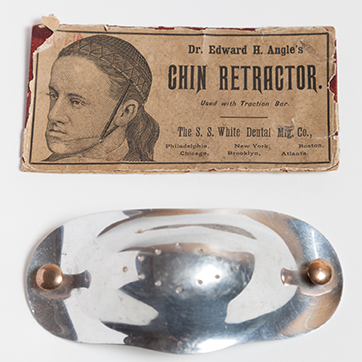Edward H. Angle’s headgear
Angle’s head gear was developed to be used in conjunction with the traction bar and arch, and the chin retractor. The head gear applied force for the reduction of protruding anterior teeth through occipital anchorage (applied by the headgear). This was an idea originally proposed by Dr. Norman W. Kingsley in 1866.
Headgear
The headgear consisted of a cap of silk netting covering the back of the head. The netting is attached to a metal rim for the even distribution of force. The headgear is attached to the traction bar or chin retractor by heavy elastic bands. The headgear could be adjusted to fit any head size and according to Angle was ‘strong, artistically made, and presents a very neat appearance’.

Cap, mouthpiece and box lid for Edward H. Angle's Head Gear, c.1900.
Chin retractor
The chin retractor was made of light, highly polished aluminium. It could fit all cases. Angle recommended a layer of absorbent cotton be placed between the retractor and chin.

Chin cap for treatment of Class 3 cases by Edward Angle, c. 1900.
Traction bar and arch
The traction bar and arch were designed for shortening the dental arch or moving distally multiple protruding incisors and cuspids. The arch was smooth and threadless designed to be used with clamp bands. The arch was prevented from sliding up and down upon the surface of the incisors by resting in notches on plain bands. Tubes on the molar bands allowed the arch to move distally. A ball in the centre of the arch fitted into a socket in the centre of the traction bar. The traction bar had a hooked end on either side for the heavy elastic bands attaching the head gear.
The traction bar and head gear could not be worn continually. When not being worn the teeth were held in place by two rubber ligatures tied in front of small immovable collars on the arch with floss silk. The ligatures were stretched distally and slipped over the ends of the anchor tubes, exerting a constant force.

Traction bar for use with Edward H. Angle's Head Gear, c.1900.